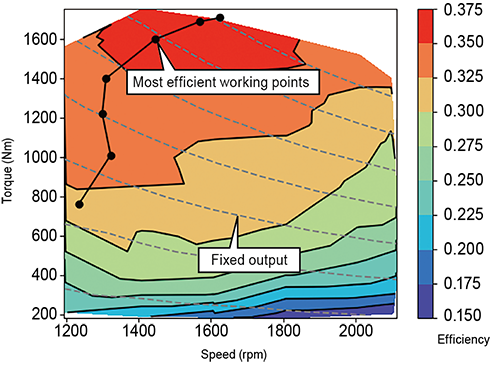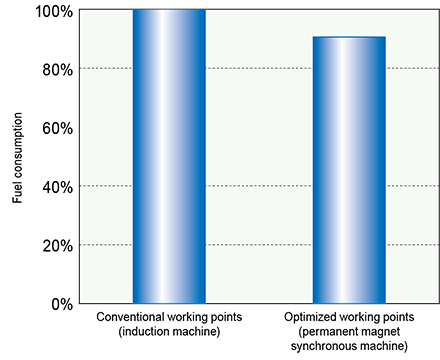22. High-efficiency generator design for diesel electric cars
Hybrid diesel and diesel electric railcars for non-electrified lines, introduced in a bid to save energy and reduce maintenance workloads, have poor mechanical power transmission efficiency compared to standard diesel hydraulic railcars, which translates to higher fuel consumption. We have designed an improved high-efficiency power generation system centered on the engine and generator.
Two factors are critical to improving the fuel consumption of the power generation system: running the engine in the high-efficiency zone, and minimizing generator losses. Engine efficiency characteristics are not widely known, and to date have not been incorporated into system design. We used detailed thermal efficiency mapping generated from unit tests to derive an efficiency map of the power generation system. We used the efficiency map to identify the most efficient working points in the engine as the basis for our generator design (see Figure 1). Engine output is proportional to the product of engine speed and torque. Our technique involves finding the optimum combination of speed and torque to deliver maximum power generation efficiency without affecting engine output.
We investigated the power generation capacity and efficiency characteristics of the induction machine and brushless synchronous machine, which have been widely used over the years, as well as the more recent permanent magnet synchronous machine. We found that the permanent magnet synchronous machine has the highest efficiency.
We demonstrated that the combination of a high-efficiency permanent magnet synchronous machine together with energy-saving modifications to the engine working points can reduce the fuel consumption of a diesel hybrid railcar by an estimated 10% (see Figure 2).
Other Contents
- 22. High-efficiency generator design for diesel electric cars
- 23. Driver advisory system for long-distance trains by speed transition estimation
- 24. Energy-saving driving operation to minimize the energy consumption during small scale delays
- 25. Modular sound insulating barriers designed to replace existing noise barriers on viaducts
- 26. Reducing aerodynamic noise and pressure fluctuation from bogies on high-speed trains
- 22. High-efficiency generator design for diesel electric cars
- 23. Driver advisory system for long-distance trains by speed transition estimation
- 24. Energy-saving driving operation to minimize the energy consumption during small scale delays
- 25. Modular sound insulating barriers designed to replace existing noise barriers on viaducts
- 26. Reducing aerodynamic noise and pressure fluctuation from bogies on high-speed trains


